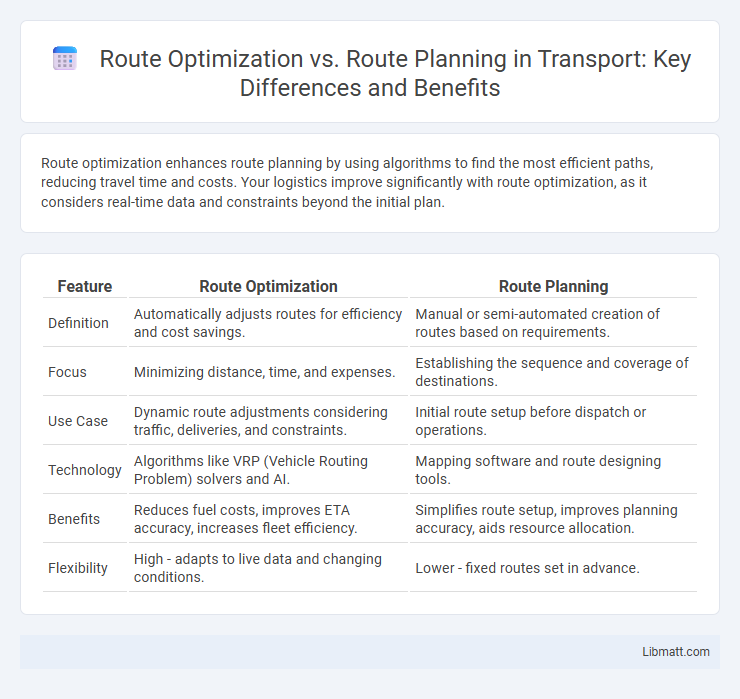Route optimization enhances route planning by using algorithms to find the most efficient paths, reducing travel time and costs. Your logistics improve significantly with route optimization, as it considers real-time data and constraints beyond the initial plan.
Table of Comparison
| Feature | Route Optimization | Route Planning |
|---|---|---|
| Definition | Automatically adjusts routes for efficiency and cost savings. | Manual or semi-automated creation of routes based on requirements. |
| Focus | Minimizing distance, time, and expenses. | Establishing the sequence and coverage of destinations. |
| Use Case | Dynamic route adjustments considering traffic, deliveries, and constraints. | Initial route setup before dispatch or operations. |
| Technology | Algorithms like VRP (Vehicle Routing Problem) solvers and AI. | Mapping software and route designing tools. |
| Benefits | Reduces fuel costs, improves ETA accuracy, increases fleet efficiency. | Simplifies route setup, improves planning accuracy, aids resource allocation. |
| Flexibility | High - adapts to live data and changing conditions. | Lower - fixed routes set in advance. |
Introduction to Route Optimization and Route Planning
Route optimization leverages advanced algorithms to determine the most efficient routes by minimizing distance, time, and fuel consumption, enhancing overall logistics and delivery performance. Route planning involves the initial process of mapping out routes based on customer locations, vehicle capacity, and service windows, setting the foundation for effective delivery schedules. Combining route planning with route optimization ensures maximum operational efficiency and cost savings in transportation management.
Key Differences Between Route Optimization and Route Planning
Route optimization uses algorithms to find the most efficient paths by minimizing travel time, distance, and costs, while route planning focuses on creating a basic schedule and map of stops without necessarily ensuring maximum efficiency. The key difference lies in optimization's dynamic adjustments, which account for variables like traffic, delivery windows, and vehicle capacity, enhancing operational efficiency. Your logistics or delivery management benefits significantly from route optimization by reducing fuel consumption and improving customer satisfaction compared to traditional route planning.
The Fundamentals of Route Planning
Route planning involves designing the most efficient path for multiple destinations based on fixed criteria such as distance, time, and stops, utilizing algorithms like the Traveling Salesman Problem. It focuses on creating a preliminary outline of the journey, taking into account factors like customer locations, service windows, and vehicle capacities. Understanding route planning fundamentals lays the groundwork for route optimization, which further refines these plans using real-time data and advanced analytics to minimize costs and improve operational efficiency.
How Route Optimization Works
Route optimization uses algorithms and real-time data to calculate the most efficient paths for multiple stops, minimizing travel time, fuel consumption, and costs. Route planning, on the other hand, involves setting a sequence of destinations without dynamically adjusting routes based on traffic, delivery windows, or vehicle capacities. Understanding how route optimization works can help your logistics operations increase productivity by automatically updating routes to adapt to changing conditions.
Benefits of Route Planning
Route planning improves delivery efficiency by determining the most logical sequence of stops, reducing travel time and fuel consumption. It helps businesses allocate resources effectively and meet customer time windows consistently. Enhanced route planning leads to lower operational costs and increased driver productivity.
Advantages of Route Optimization
Route optimization enhances delivery efficiency by calculating the most cost-effective and time-saving routes, reducing fuel consumption and vehicle wear. It improves customer satisfaction through timely arrivals and adaptable rerouting based on real-time traffic data. Your business can increase operational productivity and reduce overall transportation expenses by leveraging advanced route optimization software.
Common Use Cases for Route Planning
Route planning is commonly used for delivery services, field service management, and transportation logistics to plot the most efficient paths between multiple stops. It helps businesses schedule pickups and drop-offs, allocate resources effectively, and reduce travel time by considering factors like traffic, distance, and delivery time windows. This process sets the foundation for route optimization by creating an initial feasible route that can be further refined.
Industries That Benefit from Route Optimization
Route optimization significantly improves efficiency in industries like logistics, delivery services, and public transportation by reducing travel time, fuel consumption, and operational costs. E-commerce companies, field service maintenance, and waste management sectors also benefit from real-time route adjustments and dynamic scheduling that enhance customer satisfaction and resource utilization. Manufacturing and supply chain businesses leverage route optimization to streamline distribution networks, ensuring timely delivery and minimizing delays across multiple destinations.
Choosing Between Route Optimization and Route Planning
Choosing between route optimization and route planning depends on your specific logistics needs and operational goals. Route optimization uses algorithms to minimize travel time, fuel consumption, and costs by adjusting routes dynamically, making it ideal for real-time delivery adjustments. Route planning focuses on creating efficient routes based on predefined criteria, suitable for fixed schedules and predictable routes where initial organization is key.
Future Trends in Route Planning and Route Optimization
Future trends in route planning and route optimization emphasize the integration of artificial intelligence and machine learning to enhance real-time decision-making and adaptive routing. Advances in big data analytics enable predictive modeling, improving fuel efficiency and reducing delivery times by anticipating traffic patterns and environmental factors. The rise of autonomous vehicles and IoT connectivity further accelerates the adoption of dynamic optimization tools, creating more resilient and sustainable logistics networks.
route optimization vs route planning Infographic

 libmatt.com
libmatt.com